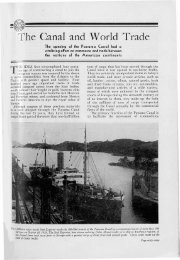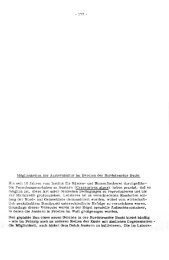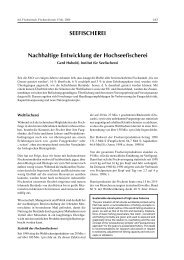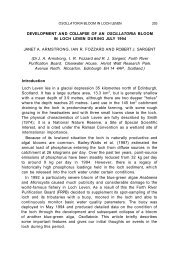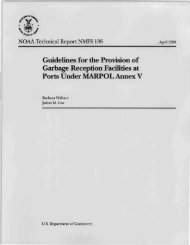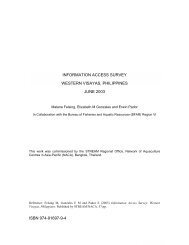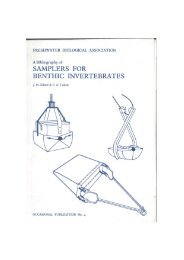The Economic Importance Of Marine Angler Expenditures In
The Economic Importance Of Marine Angler Expenditures In
The Economic Importance Of Marine Angler Expenditures In
You also want an ePaper? Increase the reach of your titles
YUMPU automatically turns print PDFs into web optimized ePapers that Google loves.
normal course of household consumption (e.g., convenience<br />
store employees spend money on groceries and<br />
pay federal and state taxes). <strong>The</strong> summation of direct,<br />
indirect, and induced effects constitute total effects.<br />
Identifying and assessing the economic effects of<br />
recreational fishing activities to communities and<br />
fishery dependent and independent businesses are<br />
important for several reasons. First, as recreational<br />
fishing becomes increasingly regulated in the U.S.,<br />
it has become important for state and federal regulators<br />
to determine how management actions will affect<br />
revenues, incomes, employment, and taxes. Secondly,<br />
documentation of recreational expenditures allows<br />
state resource management agencies to identify infrastructures<br />
that are directly and indirectly linked to<br />
angler purchases. Lastly, estimates of recreational fishing<br />
expenditures can be used to assess the economic<br />
effects of sportfishing when evaluating marina space<br />
or replacement activities for declining businesses (i.e.,<br />
manufacturing industries).<br />
<strong>In</strong> 1998, the National <strong>Marine</strong> Fisheries Service<br />
(NMFS) began a series of marine angler expenditure<br />
surveys in the coastal regions of the U.S. <strong>The</strong> surveys<br />
were conducted in the Northeast Region (NE) in<br />
1998, in the Southeast Region (SE) in 1999, and in the<br />
Pacific Region (PAC) in 2000 to evaluate recreational<br />
fishing expenditures and the economic impacts (i.e.,<br />
effects) of these expenditures in each region and<br />
the U.S. as a whole. A separate publication for each<br />
region (Steinback and Gentner, 2001; Gentner, Price,<br />
and Steinback, 2001a; Gentner, Price, and Steinback,<br />
2001b) summarized the survey results and provided<br />
state-level estimates of expenditures by marine recreational<br />
fishermen. <strong>In</strong> this report, we use the data<br />
in these three reports to assess the total economic<br />
impacts of anglers’ saltwater expenditures within<br />
each of the regions and the U.S. overall. Estimates are<br />
provided for sales, income, employment, and taxes<br />
for each coastal state in the NE, SE, and PAC in 1998,<br />
1999, and 2000, respectively. Aggregate estimates are<br />
also provided for the entire U.S., excluding Alaska,<br />
Hawaii, and Texas.<br />
<strong>Angler</strong> expenditure data were obtained directly from<br />
the three aforementioned publications (Steinback and<br />
Gentner, 2001; Gentner, Price, and Steinback, 2001a;<br />
and Gentner, Price, and Steinback, 2001b). <strong>The</strong>se data<br />
were obtained from surveys of marine recreational fishermen<br />
conducted in the NE in 1998, SE in 1999, and<br />
PAC in 2000 as part of the <strong>Marine</strong> Recreational Fisheries<br />
Statistics Survey (MRFSS). <strong>The</strong> MRFSS is a two-part<br />
survey involving a random sample of saltwater trips<br />
through an intercept creel survey and a random digit<br />
dial telephone survey of coastal households. <strong>The</strong> MRFSS<br />
has been used since 1979 to collect data to estimate<br />
fishing effort, participation, and finfish catch by marine<br />
2<br />
anglers in the U.S. Although the MRFSS has been used<br />
periodically to collect social and economic information<br />
from anglers, the 1998, 1999, and 2000 surveys were the<br />
first to obtain detailed expenditure data. For a more<br />
complete description of the MRFSS and economic addon<br />
sampling methodology, please see Steinback and<br />
Gentner (2001), Gentner, Price, and Steinback (2001a),<br />
or Gentner, Price, and Steinback (2001b).<br />
Statistical procedures were developed to account for<br />
sampling and avidity biases, and total expense estimates<br />
were provided for all expenditure items by state and<br />
resident type. Expenditure categories included triprelated<br />
goods (food, lodging, travel costs, boat fuel,<br />
party/charter fees, access or boat launching fees, equipment<br />
rental, bait, and ice), fishing equipment and semidurable<br />
items (rods, reels, lines, tackle, magazines, club<br />
dues, special fishing clothing, camping gear, binoculars,<br />
and taxidermy), and durable goods (motor boats and<br />
accessories, non-motorized boats, boating electronics,<br />
mooring, boat storage, boat insurance, and vehicles or<br />
second homes used primarily for marine angling).<br />
Methods<br />
<strong>The</strong> models<br />
<strong>In</strong>put-output models were used to estimate the total<br />
economic impacts attributable to marine recreational<br />
fishing in the NE, SE, and PAC regions of the U.S. <strong>In</strong>putoutput<br />
modeling is an approach used to describe the<br />
structure and interactions of businesses in a regional<br />
economy. <strong>In</strong>put-output models are capable of tracking<br />
quantities and purchasing locations of expenditures<br />
by anglers, support businesses, and employees in both<br />
directly and indirectly affected industries. <strong>In</strong>put-output<br />
assessments can be used to reveal how anglers’ expenditures<br />
affect the overall economic activity in a particular<br />
region, such as sales, income, employment, and taxes.<br />
For a comprehensive description of input-output modeling<br />
techniques see Miller and Blair (1985).<br />
<strong>In</strong> the analyses presented here, a regional input-output<br />
modeling system called IMPLAN Pro (Impact analysis<br />
for Planning) was used to determine the economic<br />
importance of marine recreational fishing to each<br />
coastal state in the U.S. <strong>The</strong> IMPLAN system is a widely<br />
used and nationally recognized tool that provides detailed<br />
purchasing information for 528 industrial sectors<br />
and a user-friendly media for customizing input-output<br />
models to specific applications (Minnesota IMPLAN<br />
Group, <strong>In</strong>c., 1997). <strong>The</strong> original IMPLAN system was<br />
designed in 1976 to assist the U.S. Department of<br />
Agriculture’s Forest Service with resource management<br />
planning, but it has since been modified and can now<br />
be used to generate the economic impacts resulting



